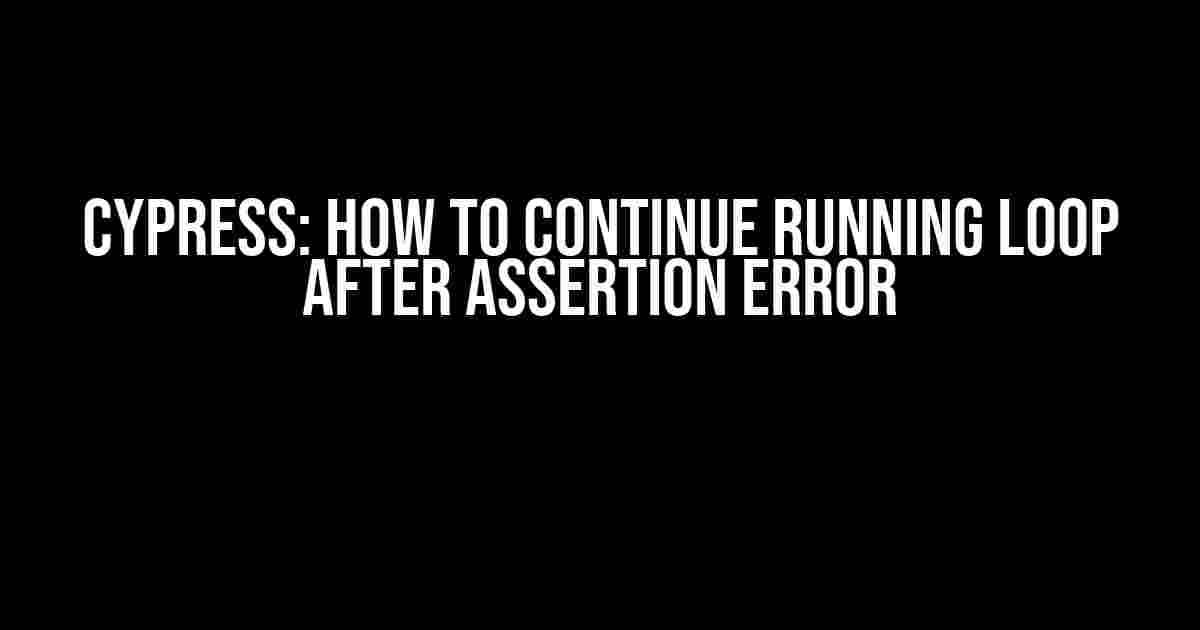When it comes to testing with Cypress, assertion errors can be a real showstopper. You’re cruising along, writing tests left and right, and then suddenly, BAM! An assertion error brings everything to a grinding halt. But fear not, dear tester, for we’re about to explore the secret to continuing your loop even after an assertion error rears its ugly head.
Why Do Assertion Errors Cause Loops to Stop?
Before we dive into the solution, let’s quickly discuss why assertion errors cause loops to stop in the first place. In Cypress, when an assertion fails, it throws an error that propagates up the call stack, halting the execution of the test. This is by design, as Cypress wants to ensure that you’re aware of the failure and can take corrective action.
However, there are situations where you might want to continue running the loop despite an assertion error. Perhaps you’re testing a critical functionality that can’t be interrupted, or you want to collect as much data as possible before the test fails. Whatever the reason, Cypress provides a way to achieve this through the use of cy.then() and cy.catch().
Using cy.then() and cy.catch()
The key to continuing a loop after an assertion error lies in using cy.then() and cy.catch() in tandem. Here’s an example:
cy.get(' selector').each(($el, index) => {
cy.then(() => {
// Perform some action that might cause an assertion error
cy.get($el).should('have.attr', 'disabled', 'true')
}).catch((err) => {
// Catch the error and continue the loop
console.error(`Error on element ${index}: ${err.message}`)
})
})
In this example, we’re using cy.get() to retrieve a list of elements, and then iterating over them using each(). Inside the iteration, we’re using cy.then() to perform an action that might cause an assertion error (in this case, checking if the element has a specific attribute).
When the assertion fails, Cypress will throw an error, which we catch using cy.catch(). By catching the error, we can prevent it from propagating up the call stack and stopping the loop. Instead, we log the error to the console and continue with the next iteration.
Best Practices for Continuing Loops after Assertion Errors
While it’s possible to continue a loop after an assertion error, it’s essential to follow some best practices to ensure your tests remain reliable and maintainable:
- Log the error: Always log the error to the console or a reporting mechanism, so you can track and debug issues.
- Handle the error: Take corrective action or provide a fallback solution to ensure the test continues executing correctly.
- Test isolation: Ensure that each iteration of the loop is isolated from the previous one, to prevent errors from affecting subsequent tests.
- Code organization: Keep your code organized and modular, so it’s easy to identify and debug issues.
Common Use Cases for Continuing Loops after Assertion Errors
Here are some common scenarios where continuing a loop after an assertion error makes sense:
- Data collection: When collecting data from a large dataset, you might want to continue collecting data even if some assertions fail.
- Critical functionality: In systems where high availability is crucial, you might need to continue executing critical functionality even if some assertions fail.
- Exploratory testing: During exploratory testing, you might want to continue exploring the application even if some assertions fail, to gather as much information as possible.
- Integration testing: In integration testing, you might need to continue testing the system even if some assertions fail, to ensure that the entire system is functioning correctly.
Conclusion
Assertion errors don’t have to be a showstopper when testing with Cypress. By using cy.then() and cy.catch(), you can continue running your loop even after an assertion error occurs. Just remember to log the error, handle it correctly, and follow best practices to ensure your tests remain reliable and maintainable.
With this newfound knowledge, you’re ready to tackle even the most complex testing scenarios and ensure that your application is rock-solid. So go ahead, continue that loop, and test like a pro!
| Method | Description |
|---|---|
cy.then() |
Executes a callback function that might cause an assertion error |
cy.catch() |
Catches and handles the error thrown by cy.then() |
Remember, the key to continuing a loop after an assertion error is to use cy.then() and cy.catch() in tandem. By following this approach, you can ensure that your tests are robust, reliable, and able to handle any unexpected errors that come their way.
Frequently Asked Question
Stuck on a Cypress testing issue? Don’t worry, we’ve got you covered! Check out these frequently asked questions about how to continue running a loop after an assertion error in Cypress.
Q1: What happens when an assertion error occurs in a loop in Cypress?
When an assertion error occurs in a loop in Cypress, the test will fail and stop executing the remaining iterations of the loop. This is because Cypress is designed to fail fast and report the error as soon as possible.
Q2: Is there a way to continue running the loop after an assertion error in Cypress?
Yes, you can use the `cy.then()` command with a callback function that returns a promise that resolves to `undefined` when an assertion error occurs. This allows the test to continue running the loop even if an assertion error occurs.
Q3: Can I use a try-catch block to catch the assertion error and continue running the loop?
No, using a try-catch block to catch the assertion error will not work in Cypress. Cypress uses a special error handling mechanism that prevents try-catch blocks from catching assertion errors. Instead, you should use the `cy.then()` command with a callback function as mentioned in Q2.
Q4: How do I skip the iteration that caused the assertion error and continue running the loop?
You can use the `cy.then()` command with a callback function that returns a promise that resolves to `undefined` when an assertion error occurs. Then, you can use the `continue` statement to skip the current iteration and move on to the next one.
Q5: Are there any best practices for handling assertion errors in loops in Cypress?
Yes, it’s a good practice to log the error message or the iteration number that caused the assertion error, so you can identify the issue later. Additionally, consider adding a retry mechanism to retry the failed iteration after a certain timeout.


